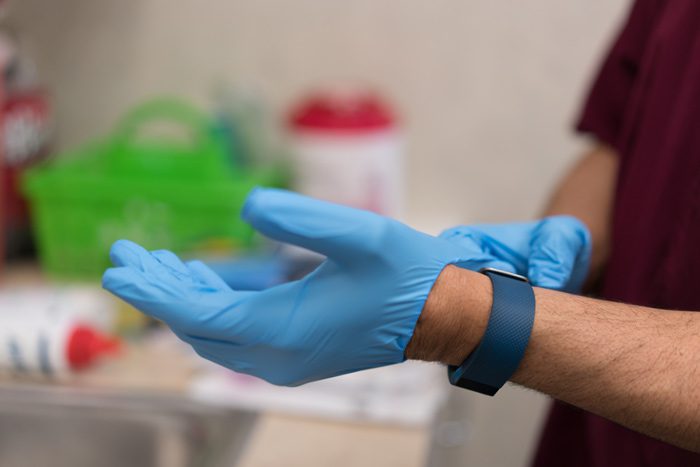What is Driving The Trend Towards Nitrile Disposable Gloves?
Nitrile vs Latex vs Vinyl
Nitrile Disposable Gloves Facts
- Nitrile has the lowest allergy rate of any glove material on the market, and Accelerator Free Nitrile gloves are now available, which makes Nitrile Gloves the most comfortable glove especially for everyday users.
- Extremely high chemical resistance, strong puncture resistance and bio hazard protection.
- Nitrile gloves can easily be donned without powder.
- In recent years Nitrile gloves have become more affordable, and today they are on par with Latex glove prices.
- Historically Nitrile gloves have not had the level of “stretch” that is associated with Latex gloves but over the last few years the revolutionary introduction of “Soft Touch Nitrile” has allowed Nitrile to become more stretchy and flexible then ever before.
- Nitrile material is considered to be food safe, and is the preferred glove material of choice for the food industry. However always check with your glove supplier to ensure your nitrile gloves are food safe.
- Nitrile gloves can be biodegradable.
- Nitrile gloves are environmentally friendly.
- Nitrile glove demand and usage around the world is rapidly increasing 10% every year because of Nitrile Disposable gloves superior features.
Summary – Nitrile disposable gloves can be used in almost any industry, with few to nil allergy issues for about the same cost as Latex gloves with no real down side.


Latex Disposable Gloves Facts
- 8 – 17% of all US health care workers have Latex allergies with users of Latex gloves in other industries experiencing similar reactions.
- If you wear latex gloves everyday, then you have a high risk of eventually developing a latex allergy or dermatitis.
- High allergy rates mean if you use Latex gloves in your industry you will more than likely need to run two types of gloves for the same task.
- Latex gloves can be difficult to don without powder, and the powder adds to the skin irritation and allergy problems.
- Latex gloves are made almost entirely from natural rubber (the rubber they make car tyres from), a raw commodity that is subject to large price movements.
- Moderate chemical and puncture resistance is associated with Latex gloves meaning their principle market is the medical industry.
- High levels of bio degradability and no issues with incineration for glove disposal.
- Worldwide sales of Latex gloves have been on a steady decline for the last six years.
Summary – The best application for latex gloves is medical with proven protection from bio hazards like bacteria and viruses, however the need for a second glove alongside remains inescapable because of allergies.

Vinyl Disposable Glove Facts
- Firstly Vinyl Disposable Gloves are really PVC Gloves. The very same PVC that is known to create large volumes of toxic chemicals when manufactured, like dioxin and vinyl chlorides.
- A PVC glove contains approximately 50-60% PVC, the other 50-40% is made up of plasticisers that make the PVC soft enough to wear.
- The most common plasticiser used in PVC gloves is phthalates DEHP this substance is currently under much scrutiny for its toxicity. DEHP has been banned from use in children’s toys around much of the world. Japan has even banned it from the use of food contact.
- The use of Bisphenol and Benzisothiazolinone in the manufacture of PVC gloves is also known to cause allergic reactions and dermatitis with prolonged use.
- Unlike Nitrile and Latex gloves the PVC glove molecules are not cross-linked leading to more holes in the glove film and high levels of bacteria and virus permeation.
- Disposing of Vinyl gloves is also an ongoing problem. The PVC takes a very long time to break down (many decades), and if incinerated large amounts of toxic emissions are generated.
- All the materials to make PVC gloves are non-renewables namely oil.
- Are extremely cost effective.
Summary – Vinyl Disposable Gloves are cheap to make and cheap to buy, but at a high cost to user health and the environment.
To Powder or Not To Powder?
Powder in disposable gloves is largely a historical leftover whose only purpose was to enable the user to don gloves so they didn’t break. This was essential when the only glove you could buy was Latex, but now unless you have wet hands every time you don a pair of gloves there is just no need for this irritant to be in the glove. This is particularly true for Nitrile gloves because they are so much stronger than Latex and Vinyl and require no powder at all.
Conclusion
The ongoing use of Vinyl gloves is a short-sighted decision for both the user and the environment, especially when there are some great alternatives in Nitrile and Latex at minimal to no additional costs. Although Latex will continue its strong use in the medical field for some time yet, the use of Nitrile disposable gloves across all market sectors worldwide will continue to grow strongly in the coming years due to the strong features and minimal drawbacks of Nitrile material.